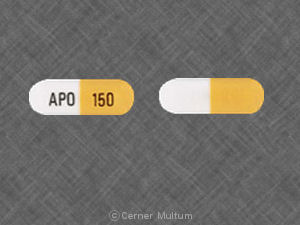Nizatidine Disease Interactions
There are 2 disease interactions with nizatidine.
H2 antagonists (applies to nizatidine) GI bleeding
Major Potential Hazard, Moderate plausibility. Applicable conditions: Gastrointestinal Hemorrhage
Histamine H2 receptor antagonists should not be used in the presence of vomit with blood, or bloody or black stools. These might be serious conditions and the diagnosis needs to be ruled out.
References
- (2002) "Product Information. Pepcid (famotidine)." Merck & Co., Inc
- (2002) "Product Information. Axid (nizatidine)." Lilly, Eli and Company
- (2001) "Product Information. Tagamet (cimetidine)." SmithKline Beecham
- (2001) "Product Information. Tritec (ranitidine bismuth citrate)." Glaxo Wellcome
- (2002) "Product Information. Zantac 75 (ranitidine)." Pfizer U.S. Pharmaceuticals
Nizatidine (applies to nizatidine) renal dysfunction
Moderate Potential Hazard, High plausibility.
Nizatidine and its metabolites are primarily eliminated by the kidney. Although the drug is generally well-tolerated, the daily dosage should be reduced in patients with moderate to severe renal impairment (CrCl < 50 mL/min).
References
- Aronoff GR, Bergstrom RF, Bopp RJ, Sloan RS, Callaghan JT (1988) "Nizatidine disposition in subjects with normal and impaired renal function." Clin Pharmacol Ther, 43, p. 688-95
- (2002) "Product Information. Axid (nizatidine)." Lilly, Eli and Company
- Gladziwa U, Klotz U (1994) "Pharmacokinetic optimisation of the treatment of peptic ulcer in patients with renal failure." Clin Pharmacokinet, 27, p. 393-408
Nizatidine drug interactions
There are 91 drug interactions with nizatidine.
Nizatidine alcohol/food interactions
There is 1 alcohol/food interaction with nizatidine.
More about nizatidine
- nizatidine consumer information
- Check interactions
- Compare alternatives
- Pricing & coupons
- Reviews (12)
- Drug images
- Latest FDA alerts (2)
- Side effects
- Dosage information
- During pregnancy
- Drug class: H2 antagonists
- Breastfeeding
- En español
Related treatment guides
Drug Interaction Classification
| Highly clinically significant. Avoid combinations; the risk of the interaction outweighs the benefit. | |
| Moderately clinically significant. Usually avoid combinations; use it only under special circumstances. | |
| Minimally clinically significant. Minimize risk; assess risk and consider an alternative drug, take steps to circumvent the interaction risk and/or institute a monitoring plan. | |
| No interaction information available. |
Further information
Always consult your healthcare provider to ensure the information displayed on this page applies to your personal circumstances.


